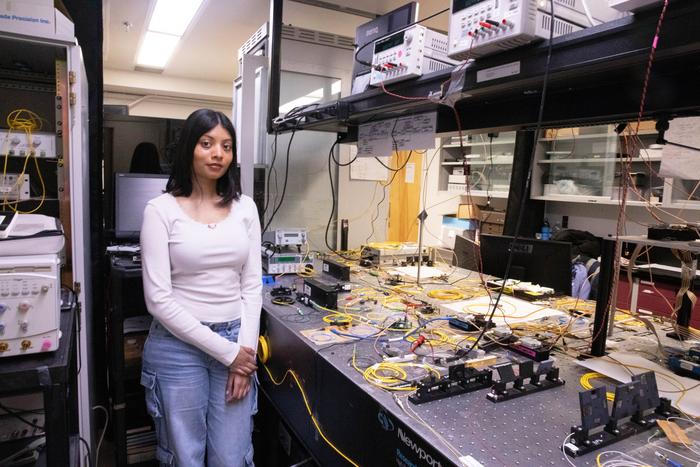A groundbreaking discovery by researchers from the University of Toronto Engineering has unveiled hidden multi-dimensional modulation side channels within existing quantum communication protocols. This revelation carries significant implications for the realm of quantum security, an area that harnesses the unique properties of quantum mechanics to safeguard the transmission of potentially sensitive information over long distances. At the core of this revelation lies the exploration of quantum sources, the pivotal devices responsible for generating quantum particles, typically photons, which are integral to secure message transmission.
In quantum communication, the security advantage over classical methods stems from the use of a property known as conjugate states, which are fundamental to quantum mechanics. According to PhD student Amita Gnanapandithan, the lead author of the related research paper published in Physical Review Letters, these states, such as position and momentum, are inherently linked. When one variable is measured, the other experiences unavoidable disturbance, effectively alerting the communicating parties to any potential eavesdropping attempts. The presence of conjugate variables ensures that an eavesdropper cannot replicate the message and access its content without introducing detectable anomalies.
Despite the apparent security provided by quantum mechanics, researchers have previously identified ways in which quantum communication can be undermined due to inherent imperfections in the devices utilized for practical implementations. Between 2000 and 2012, investigations revealed the emergence of side channels, which are loopholes that enable individuals to intercept signals without introducing detectable disturbances. This underscores the necessity of continuously evolving quantum communication methods to bolster security against possible breaches.
To counteract side channels, a novel protocol termed measurement-device-independent quantum key distribution (MDI-QKD) was developed in 2012 by Professor Hoi-Kwong Lo and collaborators. This innovative protocol effectively circumvents all side channels associated with quantum particle detectors, a significant stride towards fortifying quantum communication systems. However, Gnanapandithan’s focus shifted towards exploring potential side channels associated with the source devices, expanding the understanding of vulnerabilities in quantum communication systems.
When encoding information through optical polarization, Gnanapandithan explains the significance of employing two conjugate polarization bases in the encoding process. The objective is to restrict encoding solely to the polarization degree of freedom, thereby avoiding correlations with any additional degrees of freedom. Such correlations pose a significant threat, as they could enable an eavesdropper to glean valuable insights into the encoded polarization if they can access these other dimensions.
The study introduces the concept of dimensional assumption, asserting that the degree of freedom used for encoding should remain uncorrelated with other dimensions. A violation of this assumption indicates potential security flaws within the communication system. Regrettably, modern quantum sources frequently introduce violations due to various factors, including inherent correlations between adjacent signals, leading to the leakage of information from prior signals into subsequent ones—a phenomenon referred to as the pattern effect.
Gnanapandithan’s recent research identifies a previously overlooked source of violation stemming from the modulation process in quantum sources. The study posits that modulation can not only be distorted but may also vary dynamically over the duration of a single optical pulse. This nuanced understanding categorizes this identified flaw as "hidden multi-dimensional modulation," with the time-varying encoding representing just one instance of its occurrence within quantum communication frameworks.
The ramifications of these side channels depend significantly on the capabilities of the equipment being employed. According to Gnanapandithan, higher bandwidth equipment can facilitate modulation signals that enhance the fidelity of optical pulses. In stark contrast, devices suffering from severe bandwidth limitations could exhibit significant distortion, exacerbating the vulnerability to eavesdropping.
Furthermore, the emergence of passive quantum key distribution (QKD) sources, which do not rely on modulators, presents an intriguing perspective regarding bandwidth-related concerns. By eliminating the modulation requirement, these passive sources mitigate one potential avenue of vulnerability, presenting a worthwhile avenue for exploration in future quantum communication systems.
As the research continues, Professor Lo indicates that future work will center on developing strategies to mitigate the risks posed by these newly identified side channels. There exists room for creativity in addressing these challenges. However, he also notes the cautionary potential that new solutions may inadvertently introduce their own complexities. Recognizing the layers of complexities within quantum communication systems is critical for advancing this field effectively.
In conclusion, the discovery of hidden multi-dimensional modulation side channels represents a pivotal advancement in our understanding of quantum communication vulnerabilities. As researchers work diligently to refine quantum communication systems and explore innovative solutions, the implications for the future of secure information transmission remain profound. The findings illuminate the necessity for vigilance and continuous improvement within quantum security, driving the conversation on securing the next generation of communication technologies.
Subject of Research: Hidden multi-dimensional modulation side channels in quantum communication protocols
Article Title: Discovery of Hidden Modulation Side Channels Reshapes Quantum Communication Security
News Publication Date: [To be filled]
Web References: [To be filled]
References: Gnanapandithan, A. et al., Physical Review Letters, DOI: 10.1103/PhysRevLett.134.130802
Image Credits: Photo by University of Toronto Engineering / Tyler Irving
Keywords
Quantum information processing, Photons, Quantum correlation.




